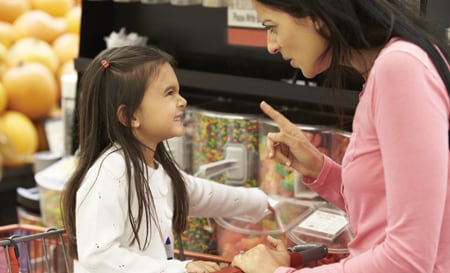Responding to Behavior

Attention from you and other caregivers is important to your child. In fact, toddlers and preschoolers demand A LOT of adult attention. Attention can be both positive and negative.
Positive Attention
Positive attention is used to show your child he has done something you like. Positive attention includes things like:
- praise
- hugs
- kisses
- pats on the back
- high-fives
Negative Attention
Negative attention lets your child know you do not like what he has done. Negative attention includes things like
- scolding
- correcting
- yelling
There are two key things to remember about attention:
- Any attention (positive or negative) your child receives right after his behavior increases the chance that the behavior will happen again.
- Negative attention becomes a problem when we use it MORE than positive attention.
Let’s take a look at an example
Example:
You are in the check-out line at the grocery store with your child.
If your child waits by your side, you might say, “Thank you for being patient and staying by me.”
If your child runs away, you yell at him, “Come back here, now!”
When to Not Give Attention
Any attention you give after your child’s behavior makes the behavior more likely to happen again. So, if you give your child attention after he does something you do not like, the misbehavior can increase.
You can decrease misbehavior by limiting the negative attention you give. Ignoring is another good way to limit attention for behaviors you do not like. Click here for more information on ignoring.
Check out Quick Tips and Answers from Experts for more info about about responding to your child’s behavior!
Click through the links below to watch videos and practice your skills for communicating with your child.
Watch Videos
Practice Skills